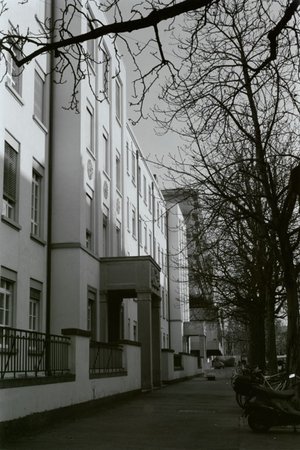The Institute of Physics
In 1926, the new building for the Institute of Physics and Physical Chemistry opened at Klingelbergstrasse 80/82, continuing the spatial expansion and diversification of the natural sciences.
A new building for physics
Initial plans for a dedicated new building for the Institute of Physics date back to 1918 and were discussed in the Grand Council in 1922. The discipline of physics was initially housed in the new museum building at Augustinergasse, and from 1874, in the Bernoullianum. There, the department initially had only two rooms; after the departure of the Department of Chemistry, physics took over its vacated spaces, supplemented by the ground floor of Mittlere Strasse 40, rented for a physics lab course. Long-standing complaints about inadequate accommodation and cramped spaces gained new urgency with the expansion and new construction of the tramway around the Spalenberg district. In addition to the issue of space shortage, it was now argued that research and teaching at the Bernoullianum site were impaired because the tramway caused electromagnetic disturbances, “wandering” currents, and vibrations – hardly conditions under which research in the field of physics could flourish. In the debates of the Grand Council, the economic situation of the time also played a role – specifically, the need to alleviate unemployment became an additional argument for constructing the new building. Eventually, the building was approved, with costs amounting to 2.4 million Swiss francs. The new building also considered the space requirements of the chemical disciplines: in 1926, together with the Institute of Physics, the Institute of Physical Chemistry, which had been located next door in the chemistry complex, moved into the new premises.
At the forefront of technology: a modern university building ...
In 1926, the building constructed for physical research and teaching at Klingelbergstrasse 80/82 was inaugurated in a ceremony that was modest compared to earlier, similar occasions. Still, the open house had to be extended by a day because of such a large public turnout: some 15,000 people took the opportunity to visit the new institutes. The interest of Basel’s residents in the university in general, and in this institute in particular, was enormous. After the other part of the Institute for Physical Chemistry was opened, it was said to be “one of the most modern and spacious institutes of its kind,” containing specialized laboratories for photochemistry, electrochemistry, and thermochemistry in addition to spaces for more general use. There was also space for ophthalmological and neurological laboratories.
The double building, adorned with an imposing entrance portal, was noted in 1930 as being designed “for the distant future” – an assessment that has proven accurate to this day. Others at the time described the interior fittings of the Institute of Physics, from the machine room to the experimental radio station, as being state of the art in science and technology, providing “all the foundations necessary” for teaching and research.
... begins to show its age
It wasn’t until the end of the 1960s that a lack of space for the discipline once again became an issue. By then, unsurprisingly, the technical equipment had also become outdated and in dire need of investment. The total renovation carried out in 1967 and 1968 cost fifteen million Swiss francs – five times more than the original construction. Now, the Institute of Physics and Institute of Chemistry were spatially connected by a common tract. Since then, numerous internal space adjustments have been made in the Institute of Physics; particularly noteworthy is the establishment of the Institute of Nanoscience in 2004.
Nanoscience – a new center in an old institute
It is rare that sciences do not expand to fill the buildings they are given. As a rule, science continuously overflows, and its physical structures are modest in relation to the substance they contain. The Swiss Nanoscience Institute – focused on the smallest units of measurement in the world (nanoscale: 1 nanometer = one-millionth of a millimeter) – is affiliated with the old Institute of Physics at Klingelbergstrasse 32. It was designated as the Leading House of the National Centre of Competence in Research (NCCR) for nanoscale science in June 2001 and forms the nucleus of a network comprising eight other research institutions with over 200 researchers.
A presentation from 2004 (internal to the university) further emphasized this contrast: “The building is solid and unpretentious. But old walls can be deceiving. This a site dedicated to researching the future.” Nanoscience, often referred to as a key technology of the twenty-first century, pursues a pluridisciplinary and interdisciplinary approach (including physics, biology, chemistry, medicine, and information technology) to explore the world of atoms and molecules. Questions from material sciences, computer technology, and medicine increasingly lead to issues in nanoscience, with the aim being the sustainable use of resources. The self-directed production of knowledge, i.e., research, is the starting point for teaching. This aim is a prerequisite for education, just as teaching is in one sense its logical consequence. This is also why a corresponding educational program was promptly introduced in this field: since the winter semester of 2002/03, the University of Basel has been offering a degree program in nanoscience with an eye to the future.



